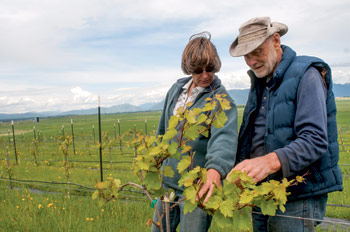The wind was brisk at the vineyard in West Kalispell, but the warm, June sunlight shone on the fledgling grapes. As a fruit, grapes are one of the more sensitive species – wind makes them cringe but sun is always welcome – and Pat McGlynn hopes to figure out what varietals work with the Flathead’s temperamental weather.
“Grapes are tender and they’re really fussy,” McGlynn said. “We’re getting around some of the issues with the new hybrids.”
McGlynn, Flathead County’s Montana State University agricultural extension agent, is a year into a trial study on 12 grape hybrids and how they fare here. Last week, two specialists visited the trial sites with local grape growers to add their expertise to the subject.
The grape trial study consists of 12 different hybrid species in four locations: West Kalispell, Ronan, Plains and Yellow Bay on Flathead Lake. The vineyards were placed in areas with existing trellis and irrigation systems.
While grapevines might be cheap to buy, the trellises and irrigation costs can range from $5,000 to $10,000 per acre, McGlynn said, depending on what kind of fencing is needed to detract bears and deer.
The West Kalispell site, owned by Roger Olson, had the infrastructure needed to house the new varieties, but McGlynn said they are learning about how wind affects the baby plants.
Wind is just one factor they’ve learned about in the past year, she said. Others include the valley’s penchant for frost pockets, which greatly affect the touchy fruit’s progress.
“The thing though that we’re learning is that there are special conditions for the grapes,” McGlynn said. “Not just anybody in the Flathead Valley is just going to be able to plop down a vineyard.”
Part of the trial study’s goals is to be able to advise future vineyard owners on what type of soil, sunlight, hill gradient and hybrid type would work best for their location, McGlynn said. And if it doesn’t look like grapes will work, these landowners are curious about what other winemaking crops could grow on their property, she said.
Larry Robertson, a soil conservationist for the U.S. Department of Agriculture’s Natural Resource Conservation Service, collaborates with McGlynn on the project, bringing together the larger farms he works with and adding to the knowledge of the smaller producers.
It used to be that someone would buy a plot of land, build a nice house and decide that a vineyard would be a nice addition to the property, Robertson said. But lately, more and more people are thinking of the vineyard first, asking which properties in the valley would support grapes, and then thinking of building their houses there.
“It’s very difficult to find the right places,” he said.
Grapes are gaining popularity, he said, and the Flathead could end up producing a high-quality fruit with superior flavors because the summer days are warm and the nights are cool.
“We’ve already proven it with our cherries,” Robertson said.
Figuring out which grapes work the best where is the challenge of the moment. While many individual growers have figured out a system that works for them, the newer, hardier hybrids might make it easier for large-scale production to take root.
 |
|
Harlene Hatterman-Valenti, left, a high value crops specialist with North Dakota State University, examines a grape vine at Roger Olson’s vineyard in West Valley. – Lido Vizzutti | Flathead Beacon |
North Dakota State University high-value crop specialist Harlene Hatterman-Valenti visited last week and toured the trial vineyards. The goal with these grapes is to get them to wake up and produce fruit quickly in the summer heat, and then get them to go to sleep early for the winter, she said.
Hatterman-Valenti said some of the newest hybrids will survive cold temperatures better than the types used in California or South America. She’s studying several types that work well in North Dakota and Minnesota, and they may work well in Northwest Montana.
And, if the current trials didn’t already have enough to consider, changing climate patterns may become an issue as well. According to a report from the National Academy of Sciences, a warmer climate and shift in water resources might make Montana one of the best areas in the country for grape production by 2050.
Existing producers are learning how to adjust their fruit production to the new hybrids. Katie Cook, an enologist from the University of Minnesota, visited with about 25 growers last weekend to discuss the high-acid content in the hybrids and the different yeasts winemakers would have to use to adapt their fermentation processes, McGlynn said.
“These are high-acid grapes and the process of winemaking will have to be done differently,” she said. “We’re learning so much.”
While Montana-made wines might not take over the national wine scene any time soon, the grapes that are being produced are in high demand, which is a good sign for future projects.
“Anything we can grow, we’ve already got sold,” McGlynn said.